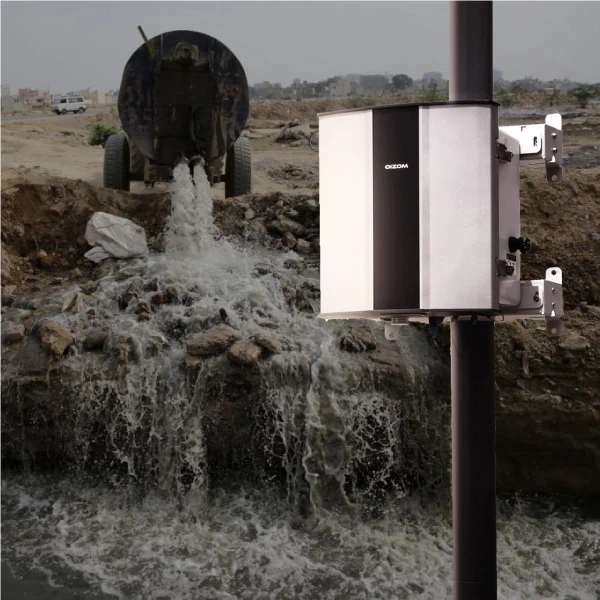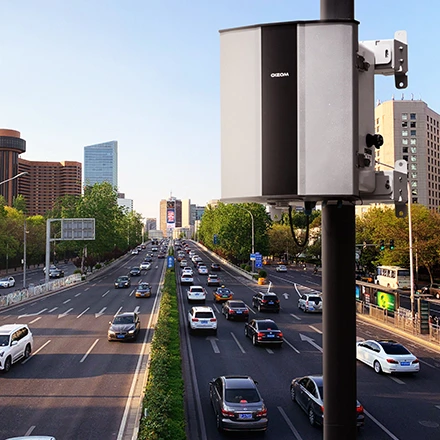Understanding about Impact of Odours on Air Quality
Odour emissions represent a substantial and often underestimated component of air pollution. These emissions comprise a complex mix of gases and particulate matter, including volatile organic compounds (VOCs), sulphur compounds, and ammonia. While some odours may simply be an inconvenience, others can have serious implications for air quality, public health, and the environment. Chronic exposure to certain odours can lead to headaches, nausea, and other health problems, not to mention the negative impact on overall quality of life.
How Odour Monitoring Systems Work
Odour monitoring systems work by continuously detecting and quantifying the concentration of various odorants in the air. Advanced systems, like those developed by Oizom, utilise sensor-based technologies, artificial intelligence, and machine learning to monitor odour emissions in real time. The collected data can then be analysed to identify the source of the odour, track its dispersion, and develop effective strategies for mitigation.
Explore Oizom’s advanced odour-monitoring solutions for a comprehensive approach to air quality management.
Detecting and Measuring Odour
The process of detecting and measuring odour involves capturing air samples and analysing them using a combination of sensory, chemical, and instrumental methods. The objective is to quantify the intensity, character, and hedonic tone of the odour.
Innovative odour monitoring systems have the ability not only to detect and measure the presence of odours but also to predict odour episodes based on weather conditions, operational data, and historical trends. This predictive capability allows for proactive odour management and control.
Applications of Odour Monitoring Systems
Odour monitoring systems have wide-ranging applications across several sectors, from industrial facilities to urban environments.
Industrial and manufacturing facilities
Odour monitoring is essential in industries such as food processing, chemical manufacturing, and paper mills, where odorous compounds are often a by-product of the production process. Continuous monitoring helps to ensure compliance with environmental regulations and manage potential odour nuisances.
Waste management and wastewater treatment plants
Waste handling and wastewater treatment processes often generate unpleasant odours. Through continuous monitoring, it is possible to identify the sources of these odours and implement effective mitigation strategies.
Agricultural operations and livestock farms
Agricultural activities, particularly livestock farming and manure management, are one of the major sources of odour in the ambient air. Monitoring these emissions can guide farmers in implementing best management practices and maintaining a harmonious relationship with the surrounding community.
Urban areas and odour nuisance hotspots
In urban environments, common sources of odour include landfill sites, sewage systems, and industrial areas. Odour monitoring in these hotspots helps to improve residents’ quality of life and ensure regulatory adherence to recommended standards.
Integrating Odour Monitoring with Air Quality Management
By integrating odour monitoring into broader air quality management strategies, it is possible to provide a more holistic understanding of air pollution. This approach enables the identification and control of pollution sources, enhances regulatory compliance, and drives efforts towards improved environmental health and sustainability.
Mitigation Strategies Based on Odour Monitoring
Odour monitoring data can generate an alert to regulatory agencies for targeted mitigation actions. These might include modifying operational processes, implementing odour control technologies, or improving waste management practices. Furthermore, predictive odour modelling can enable proactive measures to prevent odour nuisance, improving overall air quality and public satisfaction.
Regulatory Considerations and Standards
Odour monitoring plays a vital role in ensuring conformance with recommended environmental standards and regulations. As awareness of the impact of odours on air quality increases, regulators worldwide are implementing more stringent controls on odorous emissions. Compliance with these recommended standards is not only necessary from a legal perspective but also critical for maintaining the operational reputation and trust within the local community.
Odour monitoring systems, like those developed by Oizom, facilitate this compliance by continuously tracking and recording the concentration levels of various odorants. This real-time data allows for quick action when emission levels approach or exceed recommended standards. Additionally, it provides a robust audit trail for demonstrating compliance with regulators, which can be particularly beneficial during inspections or in response to public complaints.
Explore the significance of odour monitoring in sustainable farming is essential for understanding its role in promoting environment friendly agricultural practices.
Challenges and Limitations of Odour Monitoring Systems
Despite the clear benefits of odour monitoring, there are certain challenges and limitations. Firstly, the subjective nature of odour perception can complicate data interpretation, as what is considered a nuisance can vary between individuals. Secondly, external factors such as wind direction and speed, temperature, and humidity can influence the spread and intensity of odours, requiring sophisticated algorithms to predict odour dispersal accurately.
Moreover, there can be technical challenges related to sensor calibration, maintenance, and longevity. These issues, however, are being continuously addressed by companies like Oizom through ongoing research, development, and improvements in technology.
Emerging Technologies and Future Trends
The field of odour monitoring is a dynamic one, driven by innovative technologies and evolving industry needs. Advancements in sensor technologies, coupled with the rise of the Internet of Things (IoT), artificial intelligence (AI), and machine learning (ML), are revolutionising odour monitoring practices. Predictive models powered by AI and ML can analyse historical and real-time data to forecast potential odour issues, enabling proactive odour management.
Moreover, the trend towards smart cities and connected communities is driving the adoption of integrated monitoring systems that can track a range of environmental parameters, including odours, in real-time. This trend is paving the way for more comprehensive and informed urban planning and environmental management strategies.
Conclusion
Odour monitoring systems play a critical role in improving air quality, ensuring adherence to recommended standards, and enhancing community relations. As technological advancements continue to break down the barriers associated with odour monitoring, these systems will become even more integral to industries around the world.
With Oizom’s advanced odour monitoring solutions, businesses can stay ahead of regulatory requirements, manage odour emissions more effectively, and contribute to healthier, more liveable environments.
Discover Oizom’s cutting-edge odour monitoring solutions and take a step towards better air quality management today.






